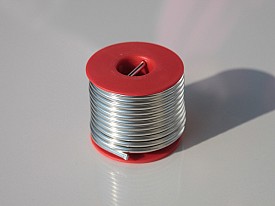Unleading Your Home
 We all know lead is toxic, which is why it's not allowed in paint and children's toys because of the associated health risks. But were you aware that many other products are allowed to contain lead, and companies don't always need to label them unless the metal exceeds a given amount? Scary thought, right? And one that might have you wondering which of the seemingly harmless items in your house is actually carrying a secret load of poison.
We all know lead is toxic, which is why it's not allowed in paint and children's toys because of the associated health risks. But were you aware that many other products are allowed to contain lead, and companies don't always need to label them unless the metal exceeds a given amount? Scary thought, right? And one that might have you wondering which of the seemingly harmless items in your house is actually carrying a secret load of poison.
Take Christmas lights, for example, many of which have lead added to the the PVC coating that covers their wires to increase flexibility and prevent cracking. This practice isn't limited to Christmas lights, actually: other lighting cords and fixtures may also have lead in their cords, and unless it's above a certain amount, the manufacturer is not required to disclose this. How can you avoid it? By purchasing products specifically labeled as lead-free, which are thankfully available from some manufacturers.
Similarly, PVC products like hoses, rain jackets, boots, shower curtains, and some miniblinds can also contain lead. Unless a product specifically states that it does not contain lead, you don't have an assurance that it's safe. Make sure that lead-free products are third-party certified, too, to ensure accountability and confirm that they really are completely free of lead.
Appliances and built-in fixtures are also legally allowed to contain lead, as are cars and boats, on the grounds that they pose less of a safety risk than interior household paint. However, these products must be supplied with a warning label indicating the presence of lead, unlike lead-backed mirrors, artists paints, and metal furniture (other than that designed for children), which can all contain lead without any notice or disclosure.
Many imported items including cosmetics, canned goods, low-cost jewelry, traditional medicines, and cheap toys can also contain lead in varying concentrations, depending on their source. While some overseas manufacturers use highly ethical and clean practices (and may certify their products as lead-free), this is not the case with all of them. If a product seems unusually inexpensive and has no disclosures about lead, you may want to proceed with caution, especially if it's something you'll be ingesting (such as canned food), applying directly to your skin (like makeup), or giving to a child who might chew or suck on it (like toys).
Want to make sure your home is as lead-free as you can get it? When you work with painters, contractors, and other building professionals, discuss their sourcing and make sure they're using lead-free products in remodels and other construction products. Some potential sources can include fasteners, fixtures, and electrical components, as well as vinyl floor coverings. Lead-free products are not necessarily that much more expensive, and the small extra cost is worth it.
Be especially careful with plumbing, as older plumbing and some newer fixtures can contain lead (in fact, the very word "plumbing" is derived from the Latin word for lead, reflecting the material once used to make pipes...scary thought, eh?). Ask your Charlotte plumber about lead in your plumbing, as it can leach out into the water and make you ill through exposure.
If you are exposed to lead, wash your hands well -- this metal must be absorbed to cause serious injury. Lead around mucus membranes like the mouth and eyes can penetrate the body quickly, but lead on the surface of the skin takes a while to absorb, and if you wash quickly, you can remove much of the toxin on your skin. And work on eliminating sources of lead in your home over time, starting with the most dangerous, including items that children and pets may gnaw, suck, or chew on.
Katie Marks writes for Networx.com.
Looking for a Pro? Call us (866) 441-6648

Electrical Average Costs
Electricians Experiences

A Great Contractor Will Guide You In Remodel Decisions That Work

Cast Iron Bathtub Replacement Was Definitely Not A DIY Project



